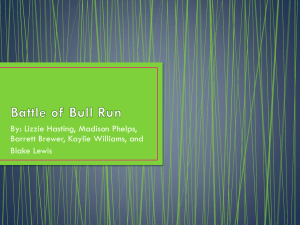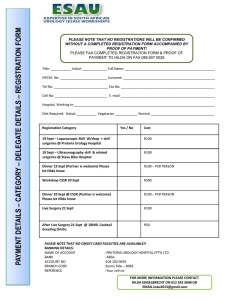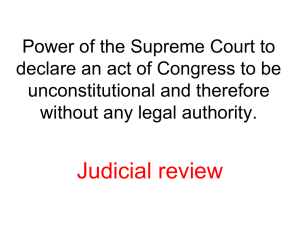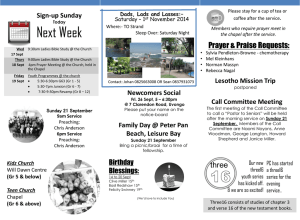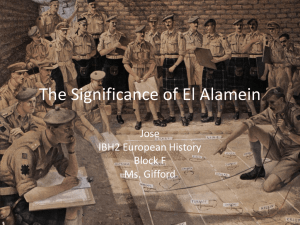The Battle of Lexington, MO, September 13th
advertisement
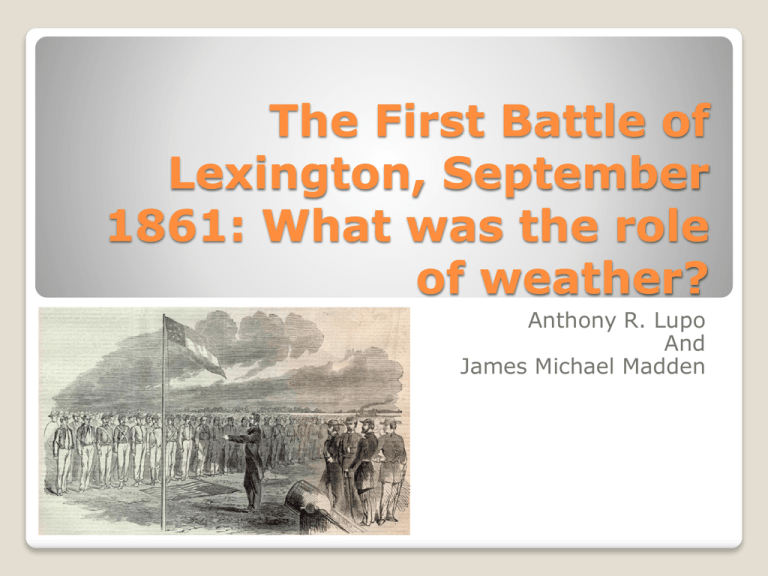
The First Battle of Lexington, September 1861: What was the role of weather? Anthony R. Lupo And James Michael Madden Pictured on the front page is the address of ex-Governor Claiborne Jackson to surrendered Union Troops (sketched by O.R. and taken from Harper’s Weekly). The first Battle of Lexington is often called the “battle of the hemp bales”, it occurred from 13-20 September and resulted in a confederate victory. Introduction The belligerents were the US Army (3,500 troops) led by Col. Robert Mulligan, and the Missouri State Guard under Maj. Gen. Sterling Price (a pro-confederate force of 12,500). In the final assault of September 20, proconfederates used hemp bales soaked in the Missouri river as shields to absorb Union artillery and arms fire. Introduction This allowed the pro-confederate force to get close enough to union positions to finally over-run them. Clearly, weather was influential in the Carthage and Wilson’s Creek engagements. How influential was it for Lexington? Introduction For this battle, unlike the other two, the weather was no longer in a summer regime. This makes reconstruction more difficult. Summer patterns over North America show much less variation, which made reconstruction fairly simple. Methods As in the other two cases, descriptions from those who were there are best to use. Records from nearby stations in Kansas were used. Also observations from Minnesota and the Eastern United States were used. Methods From the Lexington Intelligencer March 8, 1902, the Lexington Letters: W.S. Hyde(Monday Sept. 16, 1861): “It rained all day Saturday….. It is raining again this morning.” (Wed. Sept 25th) “We need some more blanket and quilts.” Descriptions of the weather From anonymous on Sept. 22. 1861 printed in the Democratic Herald in Louisiana, MO: “We lay in the trenches all of Thursday night, although it was raining hard, and some of us were without blankets.” – writer refers to Thursday Sept. 19th. Descriptions of the weather The first hand accounts suggest a wet period of weather, and at least two to three heavy rains between September 1320. Wet weather may have led to a delay in the battle, but would definitely have helped the confederate forces keep the hemp bales wet (ample river water and no drying!). Descriptions of the Weather From Minnesota, September was cold during the 6th and 7th, but very hot and humid during the 14 – 19 th. From Kentucky: Sept 16th Paducah, 70 F in the morning and 85 in the afternoon. From Philadelphia, rain on the 19th. Descriptions from outside MO From Washington DC: The 14th to the 18th was sunny and pleasant, and was likely associated with high pressure. During the 18th to the 22nd it was warm and humid. This suggests strong southerly flow and a departing high. Descriptions from outside MO The average high during this time of year today 78 F, and 54-55 F for lows. In 1861, this would be similar 75 – 78 F for a maximum and 52 – 55 F for minima. Actual readings come from Kansas. Actual Data Leavenworth, KS Date Sept Sept Sept Sept Sept Sept Sept Sept http://www.djburnette.com/research/kansas/index.html 13 14 15 16 17 18 19 20 Min Max 63 71 69 63 64 74 75 56 75F 88 F (Frontal passage - cold) 71 F 76 F (Frontal passage - warm) 87 F 90 F 92 F (Frontal Passage - cold) 64 F F F F F F F F F Actual Data There were three frontal passages and the temperatures were quite warm for the time of year. The morning of the final push was very much cooler, and a cold front had come through. The summer regime finally seems over at this point. Actual Data The data suggests quite meridional flow, cool in early September, and a strong ridge during the week of the battle. This is typical of a La Nina year. Warm weather late into the year. An active Atlantic hurricane year (1861), and a La Nina – like sea surface temperatures in the Pacific. Actual Data We examined weather maps from the early to mid fall from 2000 – 2010. The year 2007 was a La Nina like year, and the period from September 13 – 27 resembles the type of weather that would result in the descriptions above from inside and outside Missouri. The maps You can view these maps at: http://www.hpc.ncep.noaa.gov/dailywxma p/index_20070913.html The maps The weather of Mid-September 1861 was discerned from first hand sources at the Battle of Lexington. We examined data from stations relatively close to the battle site. We also examined accounts from outside Missouri. Summary and Conclusions Mid-September 1861 was quite a bit warmer than normal. A large ridge was likely covering the eastern United States. Three rain events were associated with temperature changes and likely may have delayed operations between September 13th and September 20th. The morning of the final battle followed a heavy rain and likely thunderstorms as a cold front ushered in much cooler temperatures. Summary and Conclusions Reconstructing weather for the autumn was much more difficult than for summer because of the passage of fronts and changeable conditions. Examining climate conditions, we determined 1861 must have been a La Nina year. Summary and Conclusions This rainy, wet period likely aided the proConfederate forces in using soaked hemp bales to defeat Union Forces. Thus the weather played a prominent role in the strategy used by the pro-confederate forces and the outcome, similar to that of the role of weather in the Battles of Carthage and Wilson’s Creek. Summary and Conclusions


